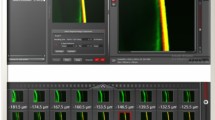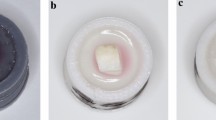Abstract
Surface substance loss of subsurface enamel lesions before (baseline/demineralization) and after each step of the infiltration technique was evaluated by means of a three-dimensional focus variation. Eighty enamel specimens were prepared and partially varnished (control). Non-varnished areas were demineralized (pH 4.95; 28 days), and etched with phosphoric acid gel (20%; 5 s). Specimens were randomly assigned to eight groups (n = 10), and were infiltrated using four resinous materials. In subgroups 1, polymerization and finishing with abrasive polishing strips followed. In subgroups 2, excess material was removed before polymerization (E1/E2-Excite, Vivadent; F1/F2-Fortify, Bisco; G1/G2-Glaze & Bond, DMG; I1/I2-Icon, DMG). Topometrical evaluation revealed a negligible substance loss of demineralized enamel. After etching, mean (±SD) differences of height decreased uniformly (−6.6 ± 2.0 μm; p = 0.089; ANOVA). For infiltrated lesions, DH of subgroups 1 was comparable to the etched lesions, with a significant increase (compared to etched lesions) in subgroups 2 (1.1 ± 0.1 μm; p < 0.001; t test). Within the limitations of this study, it is concluded that etching of initial subsurface lesions will result in significant surface substance loss; removal of excess material before light-curing should simplify the infiltration procedure, and this will avoid any abrasion resulting from polishing procedures.




Similar content being viewed by others
References
Kielbassa AM, Muller J, Gernhardt CR. Closing the gap between oral hygiene and minimally invasive dentistry: a review on the resin infiltration technique of incipient (proximal) enamel lesions. Quintessence Int. 2009;40:663–81.
Robinson C, Hallsworth AS, Weatherell JA, Kunzel W. Arrest and control of carious lesions: a study based on preliminary experiments with resorcinol–formaldehyde resin. J Dent Res. 1976;55:812–8.
Rodda JC. Impregnation of caries-like lesions with dental resins. N Z Dent J. 1983;79:114–7.
Robinson C, Brookes SJ, Kirkham J, Wood SR, Shore RC. In vitro studies of the penetration of adhesive resins into artificial caries-like lesions. Caries Res. 2001;35:136–41.
Gray GB, Shellis P. Infiltration of resin into white spot caries-like lesions of enamel: an in vitro study. Eur J Prosthodont Restor Dent. 2002;10:27–32.
Schmidlin PR, Zehnder M, Pasqualetti T, Imfeld T, Besek MJ. Penetration of a bonding agent into de- and remineralized enamel in vitro. J Adhes Dent. 2004;6:111–5.
Mueller J, Meyer-Lueckel H, Paris S, Hopfenmuller W, Kielbassa AM. Inhibition of lesion progression by the penetration of resins in vitro: influence of the application procedure. Oper Dent. 2006;31:338–45.
Paris S, Meyer-Lueckel H, Mueller J, Hummel M, Kielbassa AM. Progression of sealed initial bovine enamel lesions under demineralizing conditions in vitro. Caries Res. 2006;40:124–9.
Paris S, Meyer-Lueckel H, Kielbassa AM. Resin infiltration of natural caries lesions. J Dent Res. 2007;86:662–6.
Meyer-Lueckel H, Paris S. Improved resin infiltration of natural caries lesions. J Dent Res. 2008;87:1112–6.
Paris S, Meyer-Lueckel H, Colfen H, Kielbassa AM. Resin infiltration of artificial enamel caries lesions with experimental light curing resins. Dent Mater J. 2007;26:582–8.
Meyer-Lueckel H, Paris S. Progression of artificial enamel caries lesions after infiltration with experimental light curing resins. Caries Res. 2008;42:117–24.
Meyer-Lueckel H, Paris S, Kielbassa AM. Surface layer erosion of natural caries lesions with phosphoric and hydrochloric acid gels in preparation for resin infiltration. Caries Res. 2007;41:223–30.
Kielbassa AM, Ulrich I, Treven L, Mueller J. An updated review on the resin infiltration technique of incipient proximal enamel lesions. Med Evol. 2010;26(4):3–15.
Mueller J, Yang F, Neumann K, Kielbassa AM. Surface tridimensional topography analysis of different materials and finishing procedures after resinous infiltration of subsurface bovine enamel lesions. Quintessence Int. 2011;42:135–47.
Belli R, Rahiotis C, Schubert EW, Baratieri LN, Petschelt A, Lohbauer U. Wear and morphology of infiltrated white spot lesions. J Dent. 2011;39:376–85.
Cardenas Flores A, Flores Reyes H, Gordillo Moscoso A, Castanedo Cazares JP, Pozos Guillen Ade J. Clinical efficacy of 5% sodium hypochlorite for removal of stains caused by dental fluorosis. J Clin Pediatr Dent. 2009;33:187–91.
Rutkunas V, Sabaliauskas V, Mizutani H. Effects of different food colorants and polishing techniques on color stability of provisional prosthetic materials. Dent Mater J. 2010;29:167–76.
Tschoppe P, Kielbassa AM. Remineralization of enamel subsurface lesions: effects of different calcium-phosphate saturations in buffered aqueous solutions. Quintessence Int. 2011;42:501–14.
Kielbassa AM, Gillmann L, Zantner C, Meyer-Lueckel H, Hellwig E, Schulte-Monting J. Profilometric and microradiographic studies on the effects of toothpaste and acidic gel abrasivity on sound and demineralized bovine dental enamel. Caries Res. 2005;39:380–6.
Silverstone LM. The surface zone in caries and in caries-like lesions produced in vitro. Br Dent J. 1968;125:145–57.
White WD, Nancollas GH. A rotating disc study of enamel dissolution in HEDP solution under simulated white spot conditions. J Dent Res. 1980;59:1180–6.
Featherstone JD, Holmen L, Thylstrup A, Fredebo L, Shariati M. Chemical and histological changes during development of artificial caries. Caries Res. 1985;19:1–10.
Yu H, Wegehaupt FJ, Wiegand A, Roos M, Attin T, Buchalla W. Erosion and abrasion of tooth-colored restorative materials and human enamel. J Dent. 2009;37:913–22.
Rocha Gomes Torres C, Borges AB, Torres LM, Gomes IS, de Oliveira RS. Effect of caries infiltration technique and fluoride therapy on the colour masking of white spot lesions. J Dent. 2011;39:202–7.
Kielbassa AM, Paris S, Lussi A, Meyer-Lueckel H. Evaluation of cavitations in proximal caries lesions at various magnification levels in vitro. J Dent. 2006;34:817–22.
Paris S, Bitter K, Naumann M, Dorfer CE, Meyer-Lueckel H. Resin infiltration of proximal caries lesions differing in ICDAS codes. Eur J Oral Sci. 2011;119:182–6.
Davidi MP, Beyth N, Sterer N, Feuerstein O, Weiss EI. Effect of liquid-polish coating on in vivo biofilm accumulation on provisional restorations: part 1. Quintessence Int. 2007;38:591–6.
Davidi MP, Beyth N, Weiss EI, Eilat Y, Feuerstein O, Sterer N. Effect of liquid-polish coating on in vitro biofilm accumulation on provisional restorations: part 2. Quintessence Int. 2008;39:45–9.
Endo T, Finger WJ, Kanehira M, Utterodt A, Komatsu M. Surface texture and roughness of polished nanofill and nanohybrid resin composites. Dent Mater J. 2010;29:213–23.
van Landuyt KL, Snauwaert J, De Munck J, Peumans M, Yoshida Y, Poitevin A, Coutinho E, Suzuki K, Lambrechts P, Van Meerbeek B. Systematic review of the chemical composition of contemporary dental adhesives. Biomaterials. 2007;28:3757–85.
Rueggeberg FA, Margeson DH. The effect of oxygen inhibition on an unfilled/filled composite system. J Dent Res. 1990;69:1652–8.
Acknowledgments
The authors are indebted to Dr. Konrad Neumann (Department of Biometry and Clinical Epidemiology, CharitéCentrum 4, Charité - Universitätsmedizin Berlin, Germany) for statistical supervision. Charité - Universitätsmedizin Berlin holds US and European patents for an infiltration technique for dental caries lesions in which two of the authors (JM, AMK) are appointed as inventors, and receive royalties. These patents have been licensed by DMG (Hamburg, Germany), and DMG has marketed the infiltrant studied in this report. No external funding, apart from the support of the authors’ institutions, was available for this investigator-initiated study.
Conflict of interest
None of the authors is involved in a potential conflict of interests. Relationship between authors (JM, AMK) and manufacturer (DMG) has been disclosed in Acknowledgements.
Author information
Authors and Affiliations
Corresponding author
Additional information
F. Yang and J. Mueller have contributed equally to this study.
Rights and permissions
About this article
Cite this article
Yang, F., Mueller, J. & Kielbassa, A.M. Surface substance loss of subsurface bovine enamel lesions after different steps of the resinous infiltration technique: a 3D topography analysis. Odontology 100, 172–180 (2012). https://doi.org/10.1007/s10266-011-0031-4
Received:
Accepted:
Published:
Issue Date:
DOI: https://doi.org/10.1007/s10266-011-0031-4




